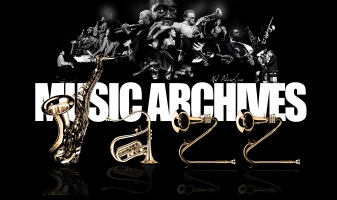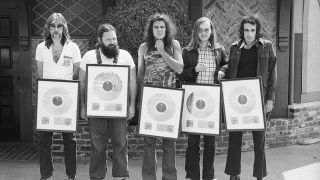
 |
Steely Dan: a guide to their best albums |
Post Reply 
|
| Author | |
snobb 
Forum Admin Group 

Site Admin Joined: 22 Dec 2010 Location: Vilnius Status: Online Points: 28446 |
 Post Options Post Options
 Thanks(0) Thanks(0)
 Quote Quote  Reply Reply
 Topic: Steely Dan: a guide to their best albums Topic: Steely Dan: a guide to their best albumsPosted: 12 Nov 2018 at 11:26am |
|
By Paul Elliott East Coast brainiacs Donald Fagen and Walter Becker (Steely Dan) brought jazz smarts and lyrical sophistication to rock. But where to start?
(Image: © Michael Ochs Archives / Getty Images) Of all the smartasses that ever made a career out of rock’n’roll, such as Frank Zappa, Todd Rundgren and 10cc, none played it smarter than Donald Fagen and Walter Becker, the co-leaders of Steely Dan. To sell 40 million albums, as the Dan have, is no mean feat. But they did it with the most sophisticated and highbrow music ever recorded by a major rock group. The fact that their group were named after a dildo – as featured in William S. Burroughs’s 1959 novel The Naked Lunch – is typical of the subversive edge and sly humour that has always been a feature of Fagen and Becker’s art. All this is what made them, in the words of Rolling Stone magazine, “the perfect musical anti‑heroes of the 70s”. Fagen, from New Jersey, and Becker, from New York City, met in college on the East Coast and worked, unsuccessfully, as musicians and songwriters for hire before relocating to Los Angeles and forming Steely Dan in 1971. The original line-up featured Fagen (lead vocals and keyboards) and Becker (bass) plus guitarists Denny Dias and Jeff ‘Skunk’ Baxter, drummer Jim Hodder and a second lead singer, David Palmer, enlisted because Fagen was prone to stage fright, and the band’s label thought his voice didn’t cut it. However, after one album, 1972’s Can’t Buy A Thrill, Palmer was out. And over the next eight years, the personnel on Dan records was ever-changing, as Fagen and Becker used the finest talent available, including Toto drummer Jeff Porcaro, the Doobie Brothers’ singer Michael McDonald, and jazz musos, guitarist Larry Carlton and pianist Joe Sample. Steely Dan’s music is typically classified as ‘jazz rock’, but the genius of Fagen and Becker was to fuse these two elements with funk rhythms and a pop sensibility evident in the hits Do It Again, Reelin’ In The Years and Rikki Don’t Lose That Number. 1980’s Gaucho was the end of their golden run: they split a year later, and a whole decade passed before a reunion in 1993. Since then, there have been just two more albums. No matter. During their imperial phase, the Dan created something unique: a balance of slick West Coast groove and dry East Coast wit. As Time magazine put it: “Sensuous and sinister, like a lazing snake coiled under the sun. Probably poisonous too…”
Essential - Steely Dan’s classic albums
Can’t Buy A Thrill – ABC, 1972 From the get-go, the Dan were the coolest band in America. This much is evident in their debut album’s two hit singles: the first, Do It Again, with a Latin rhythm and a melodic glow at odds with its lyrics about a loser beaten down by life; the second, Reelin’ In The Years, a breezy rock’n’roll number with killer lead guitar from Elliott Randall. Absent from this album was the jazzy vibe that came to define the
band in later years. But there were great songs throughout: from the
deftly funky Midnight Cruiser to the soul ballad Dirty Work, the latter beautifully sung by the soon-to-be-axed David Palmer.
It seems apt that Ian Dury was a Steely Dan fan. He did, after all, have a song called There Ain’t Half Been Some Clever Bastards. But Dury didn’t just connect to Aja on a purely intellectual level. “It’s got a sound that lifts your heart up,” he said. For all the cynicism that was so much a part of Steely Dan – an extension of Fagen and Becker’s personalities – the group’s sixth album was pure feel-good music, a glittering synthesis of soft rock, jazz, funk and pop. Most uplifting of all was the US hit single Peg, with Doobie Brother Michael McDonald gilding the chorus. Fagen and Becker had always strived for perfection. In Aja, they found it. Superior - Reputation-cementing choices
It wasn’t just their first album to hit the US Top 10. In another key respect, Pretzel Logic was a game changer for Steely Dan. After their second album, Countdown To Ecstasy, flopped, Fagen and Becker upped the ante on this follow-up, bringing in top session musicians, including drummer Jim Gordon, who’d played with George Harrison and Eric Clapton. From this point, the Dan weren’t a band per se; it was all about Donald and Walter. A perfect pop song, Rikki Don’t Lose That Number became their biggest hit single. And the quality in this album ran deep, from the balmy Any Major Dude Will Tell You to the bluesy title track.
Donald Fagen apparently hated the artwork for The Royal Scam, originally commissioned for a Van Morrison record that was never released. But the music was right on the money. Kid Charlemagne has a silky melody and a mind-blowing guitar solo from jazz-fusion pioneer Larry Carlton, and The Fez is nonchalantly funky. But the album’s best song is the reggae-influenced Haitian Divorce, with its wonderfully evocative opening couplet: ‘Babs and Clean Willie were in love they said/So in love, the preacher’s face turned red.’ Haitian Divorce is the Dreadlock Holiday it’s okay to like, and The Royal Scam is classic Dan.
No Dan album has divided opinion like Gaucho. The New York Times called it “the best album of 1980”; Rolling Stone described it as “the kind of music that passes for jazz in Holiday Inn lounges”. The truth is somewhere in between. Gaucho is a monument to anal-retentive excess, recorded over two years, utilising 42 different musicians. Even so, it’s flawed: the bland Glamour Profession is style over substance. But there are great songs on Gaucho. The title track is mesmeric, and in the zinging Hey Nineteen, Fagen makes a sleazy come-on sound magical: ‘The Cuervo Gold/The fine Colombian/Make tonight a wonderful thing.’
The Nightfly – Warner Bros, 1982 Donald Fagen’s first solo album, released a year after the Dan split, was as smooth and swinging as the band’s best work. He’s made three other solo records since then, but The Nightfly is still the biggest – a million-seller – and the best. While the overall sound was modern, the lyrical content evoked the
suburban America of Fagen’s 50s youth, with a warmth in contrast to the
Dan’s emotional detachment. And with a stellar cast of musicians (Jeff
Porcaro included), Fagen delivered a set of immaculately crafted songs,
from I.G.Y. to New Frontier and the title track. Even without Becker, Fagen had created a masterpiece. Good - Worth exploring
Countdown To Ecstasy – ABC, 1973 Fagen and Becker pulled off quite a trick on the Dan’s second album. While Countdown To Ecstasy had more of a rock’n’roll edge than Can’t Buy A Thrill, it was also when the duo’s jazz influences came to the fore. Prominent among the rockier songs were Bodhisattva, with its boogie riff, and Show Biz Kids, on which guitar hero Rick Derringer played slide. But even in these tracks there were jazzy nuances, and elsewhere this sensibility was overt in the subtle textures of Your Gold Teeth and Razor Boy. With Fagen as sole lead vocalist, it was a strong and cohesive album. All it lacked was a hit, like Do It Again.
Such was the band’s profile after the success of Pretzel Logic that this follow-up was a gold record in the US, even though its two singles didn’t really stick. Black Friday, a swaggering rock song, peaked at 37, and the laid‑back Bad Sneakers failed to make it into the Top 100. It’s the deep cuts that make Katy Lied a favourite among Dan connoisseurs: Doctor Wu, a jazz tune as smooth as glass, and Your Gold Teeth II,
with an effortlessly cool groove that’s right in the pocket. Making
these tracks swing was drummer Jeff Porcaro, already, at 20, a master of
his art. Meanwhile, Michael McDonald, debuting with the Dan, brought a
little soul into the mix.
Two Against Nature – Giant, 2000 It was a long time coming. Twenty years had passed since Fagen and Becker had made a new Steely Dan album. It had been seven years since they’d reunited and begun touring again. And yet, on Two Against Nature, they just picked up where they had left off with 1980’s Gaucho. Their signature sound was immediately apparent in the opening track, Gaslighting Abbie. And so it continued, through Cousin Dupree – as funny as it is funky – on to the jazz-noodling finale, West Of Hollywood. The album sold a million in the US and won four Grammys. On every level, the Dan’s comeback was a triumph. Avoid
Everything Must Go – Reprise, 2003 No Steely Dan record for 20 years, then two in three years, and then nothing for 13 years. For a band as unorthodox as this, it makes a strange kind of sense. But if this album does turn out to be their last, it’s a bit of a bum note to go out on. Everything Must Go (the only Dan album not to go gold) is
not a bad record. In all their years together, Fagen and Becker have
never made an outright turkey. But for all the craft and detail in this
album’s music and lyrics, there isn’t one truly great song, and no
flashes of the pop genius in their past hits – only what one critic
called “a mood of well-heeled world-weariness”. from www.loudersound.com |
|
 |
|
Post Reply 
|
|
|
Tweet
|
| Forum Jump | Forum Permissions  You cannot post new topics in this forum You cannot reply to topics in this forum You cannot delete your posts in this forum You cannot edit your posts in this forum You cannot create polls in this forum You cannot vote in polls in this forum |